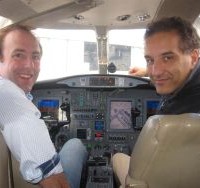
General
Re-equipped Citation makes first precision landing using satellite navigation
The research aircraft recently completed a successful flight test after the aircraft had been re-equipped with a completely new cockpit.
This maiden flight in Canada was a resounding success, marking the first time the Citation had ever landed using a satellite navigation system. This LPV/WAAS approach is comparable to the ILS (Instrument Landing System) precision approach, but uses satellite navigation instead. An advantage of an LPV/WAAS approach is that it is much less expensive than the reliable but expensive ILS, and, moreover, an approach made using satellite navigation requires no electronic facilities on the runways.
LPV/WAAS stands for ‘Localizer Performance with Vertical guidance, Wide Area Augmentation System’. This system uses the Global Positioning System (GPS), and extra beacons significantly extend the GPS system’s accuracy. The system also has another added advantage, as an NLR spokesperson explained: ‘ILS operates in the FM broadcast band, which is increasingly beset by the various radio and television stations. This isn’t a problem with the frequency band that LPV/WAAS uses.
For the maiden flight test, the Citation took off from Toronto Pearson International (CYYZ) and landed using the new LPV/WAAS approach at Kitchener Waterloo (CYKF), an airport outside of Toronto.
This TU Delft and NLR research aircraft has been in Canada, having its cockpit upgraded. The aircraft is now equipped with the latest cockpit displays and onboard avionics. With this upgrade, the Citation can now serve as a state of the art research plane for the next ten years, capable of conducting all manner of flight tests for the testing of various procedures and technologies.
The most eye-catching features of the new cockpit are the three large displays. The two screens on the right can be replaced by experimental displays, allowing new interfaces to be tested. Moreover, the plane now has new and faster data processing capabilities and new sensors for precisely determining position angles.

